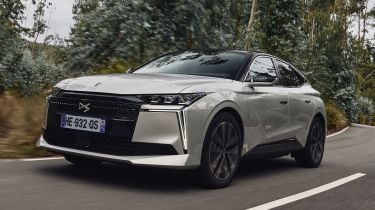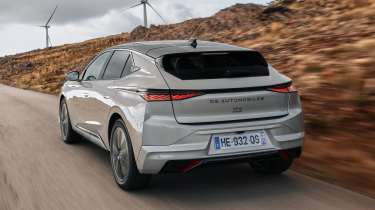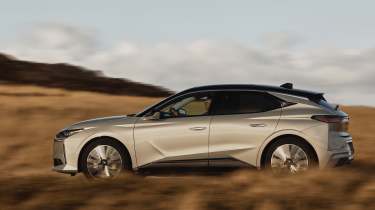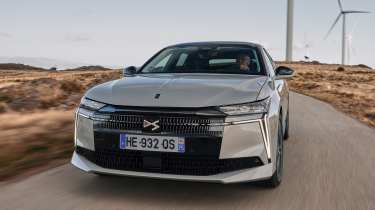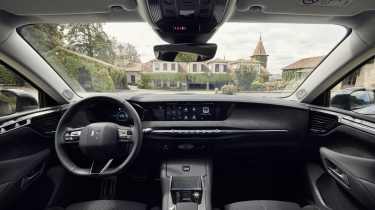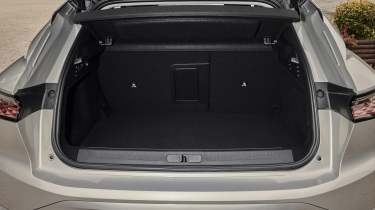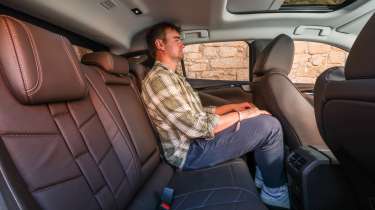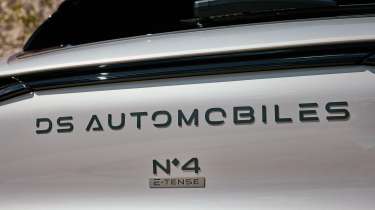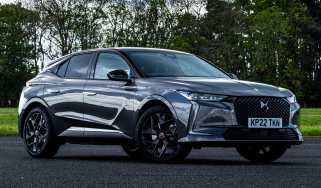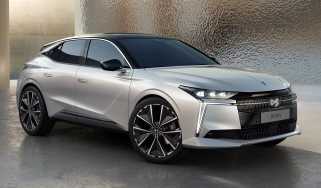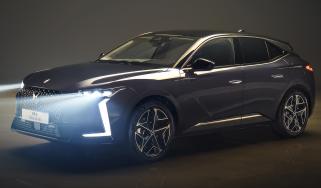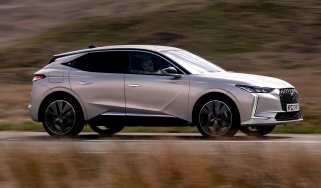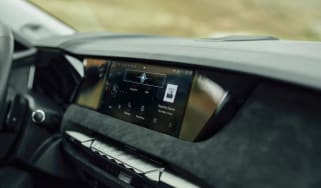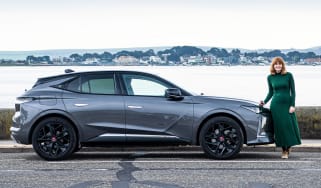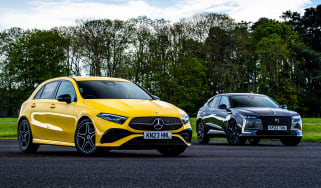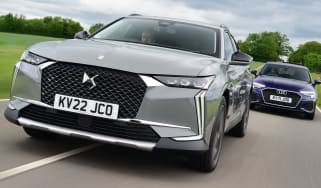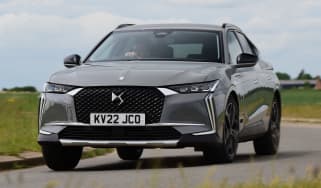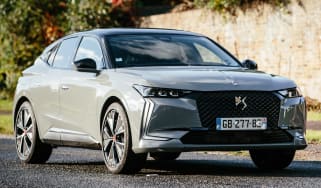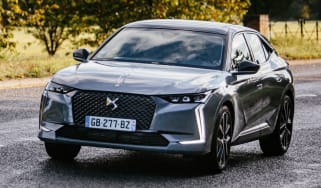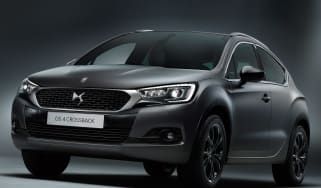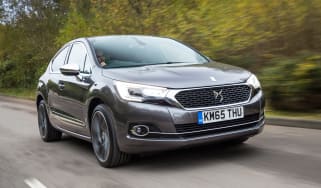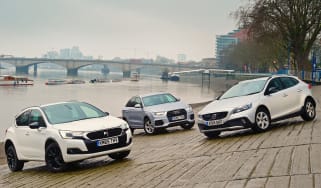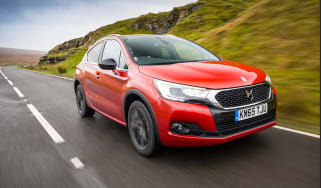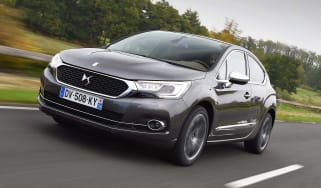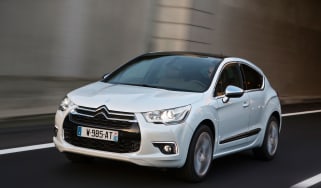DS No4 review
Delivering supreme comfort, premium feel and a wide choice of engines, the DS No4 hatchback is an interesting alternative to class-leading rivals

Our opinion on the DS No4
The DS No4 hatchback is certainly a distinctive offering in the competitive, premium family hatchback market and one that has plenty of appeal. A smooth ride and refined character help it mount a real challenge to the established players, while its interior and exterior design along with generous standard kit gives buyers further reason to favour the French hatch.
Overall practicality is okay with rather cramped rear seats giving way to a sizeable boot. There’s also lots of useful onboard technology, although you will have to pay extra for the full suite of infotainment and safety systems. Even though it’s now available as an EV too, the DS No4 isn’t blessed with intoxicating performance or class-leading efficiency, instead it’s the general levels of comfort that make it really stand out from the crowd, offering levels of substance to match its undoubted style.
About the DS No4
The second-generation DS 4 arrived in 2021 and in 2025 it received a facelift which not only changed its name to DS No4, but also brought a new look and an all-electric E-Tense variant - to help bring it inline with the new No.8 flagship. The addition of an EV means the No4 not only has to compete with the likes of the BMW 1 Series, Audi A3 and Mercedes A-Class, but the Volkswagen ID.3, Cupra Born and even lower-spec versions of the Tesla Model 3. The all-electric DS No4 E-Tense comes with a 58.3kWh battery that allows for a range of up to 280 miles.
Used - available now

2023 Land Rover
Range Rover Velar
47,379 milesAutomaticDiesel2.0L
Cash £29,700
2022 Volvo
XC40
73,942 milesAutomaticPetrol1.5L
Cash £16,900
2016 Ford
Focus
28,745 milesAutomaticPetrol1.6L
Cash £9,400DS updated the rest of the powertrains offered with the No4 too in 2025. Effectively replacing the old PureTech 130 petrol and BlueHDi 130 diesel, there’s a new 145bhp ‘Hybrid 145’. A revised plug-in hybrid courtesy of a larger battery pack has up to 50 miles in electric range - 30 per cent more than the old DS 4 PHEV. A diesel will be added to the DS No4 range in 2026 - though we don’t expect this to be made available in the UK.
DS No4 prices and latest deals
The DS No4 has three trim levels to pick from, the entry-level Pallas, the Etoile and the Etoile Nappa Leather (which is essentially just Etoile with a Nappa Leather option, as the name suggests). They’re all offered on all three powertrains with the hybrid starting at just over £32,000, the pure-electric starting at just under £37,000 (including the Government’s Electric Car Grant) and the plug-in hybrid priced from £39,000.
The No4 is already available to order now on the Auto Express Buy A Car service where you can choose the best offer from dealers around the UK. There are plenty of attractive leasing deals too, not to mention some attractive used DS 4 alternatives.
Performance & driving experience
Pros |
|
Cons |
|
There’s a lot of sharing of technology within the Stellantis family and while it may be pitched as a more premium brand compared to its contemporaries, DS is no exception. The No4 uses the same EMP2 platform that can be found under the Peugeot 308 and Vauxhall Astra - though this does allow for a wide variety of powertrains.
While the hybrid, plug-in hybrid and EV certainly offer distinct advantages and disadvantages, they’ve not all been created equal - we found the one best-suited to the No4’s character is the new all-electric E-Tense.
| Model | Power | 0-62mph | Top speed |
| DS No4 Hybrid 145 | 145bhp | 9.5 seconds | 126mph |
| DS No4 Plug-In Hybrid | 222bhp | 7.4 seconds | 145mph |
| DS No4 E-Tense | 213bhp | 7.1 seconds | 99mph |
Performance, 0-60mph acceleration and top speed
The Hybrid 145 is made up of a 1.2-litre three-cylinder turbocharged petrol engine with a supplementary 28bhp electric motor mated to its six-speed dual-clutch automatic gearbox. Despite being comfortably the slowest to 62mph out of the three, it never feels underpowered in the No4 thanks to the smooth-shifting gearbox rarely being caught out. You can also rely on the electric motor for a useful amount of low-speed driving, though we didn’t quite match DS’ claim of 50 per cent of urban driving. Overall, the Hybrid 145 unit is no different here to the many other Stellantis products we’ve tested it in.
Despite having similar acceleration figures to the plug-in hybrid, the E-Tense feels the sprightliest of the trio by far. That’s thanks to the instantaneous torque, but it’s seamless in its power delivery. That’s not the case with plug-in hybrid, which gets the same 1.6-litre four-cylinder turbocharged engine from before, but is mated to a 14.6kWh battery (replacing the 12.4kWh unit). The PHEV’s engine is quite noisy under load and the gearbox can be clumsy in its shifts. There are a set of manual gearshift paddles behind the wheel, but they often didn’t respond to our inputs.
Running in pure-electric mode is where the plug-in hybrid feels at its best - leading us to think the all-electric E-Tense is the best to drive of the three. The PHEV can get up to 83mph on electric power alone though and there’s just enough oomph from its 125bhp electric motor.
Town driving, visibility and parking
At slow speeds the DS No4 can occasionally crash into potholes and drain covers - especially in heavier E-Tense and plug-in hybrid guise with the Hybrid 145 seemingly skipping over them more often.
The No4 has a relatively high dash but frontal visibility is decent and the slightly jacked-up ride (compared to other conventional hatchbacks) does help with placing the DS on tight roads. Rear visibility isn’t great with thick rear pillars, though all models come with rear parking sensors and a reversing camera.
Country road driving and handling
There’s the usual ‘Sport’ or in the PHEV a ‘Hybrid’ mode, though ‘Comfort’ mode is the most natural choice for us. Switching modes changes things like the throttle mapping and steering weight (the latter is quite noticeable), but the DS No4 doesn’t pretend to offer the same sporty driving experience that some of its German counterparts do. Should you wish to sling the No4 into a bend you’ll be met with a bit of roll thanks to the almost crossover-like ride height and comfort-oriented suspension, but it’s all kept in check thanks to decent amounts of grip.
The Hybrid 145 is the lightest by some way at 1,454kg compared to the plug-in’s 1,663kg and the E-Tense’s 1,793kg. This does mean the hybrid can be jostled into corners more keenly, though the EV felt like it had less body roll to us - likely down to the battery’s weight and placement in the floor. The braking is also much better calibrated in the EV than it is in the other cars, where they often gave us a vague pedal feel.
Motorway driving and long-distance comfort
With one of DS’ main ‘brand pillars’ being ‘Comfort’, the No4 isn’t set up to blow you away in the bends or speed away on the straights. The ride is excellent for a hatchback, especially in the E-Tense - where the damping complements the extra weight of the battery very well. After long motorway journeys we have no doubt you’ll feel just as refreshed (if not more) in the DS compared to its German rivals.
The EV is the most refined of the bunch with an almost silent powertrain (there’s a slight hum under acceleration and wind noise is slightly more noticeable). The plug-in hybrid was just as quiet in EV mode, though we found the petrol engine bursting into life resulted in some rattles in the transmission tunnel, which was concerning. Surprisingly, the mild-hybrid’s three-cylinder encroached into the cabin less than the PHEV’s four-cylinder.
“DS’ approach to comfort in the No4 is to be expected given its history but it’s still refreshing alongside overly-firm alternatives from Germany. We’d have no problem running the EV’s 280-mile claimed range to zero, though the plug-in hybrid’s set up feels flawed to us.” - Alastair Crooks, Senior News Reporter
MPG & running costs
Pros |
|
Cons |
|
No matter which powertrain you choose, the DS No4 will be more efficient and produce less emissions than the old DS 4.
However, during our test of the Hybrid 145 and the plug-in hybrid we didn’t quite match the claimed figures with the hybrid managing 42.2mpg and the PHEV 68.8mpg after a combination of electric-only driving and running that 1.6-litre petrol. It’s worth noting that this was after lots of urban and country road driving, we have no doubt that the mild-hybrid in particular would get nearer to its claimed figure of 54.3mpg on a gentle cruise. Like any other PHEV, the DS No4 Plug-In Hybrid relies heavily on electric-only running to get anywhere near its 263.8mpg claim.
| Model | MPG | CO2 | Insurance group |
| DS No4 Hybrid 145 | 54.3mpg | 117g/km | 21 |
Electric range, battery life and charge time
Range figures for the all-electric DS No4 E-Tense aren’t Earth-shattering, but they are at least competitive with rivals like the smaller battery versions of the Cupra Born (265 miles) and the Kia EV3 (270 miles).
You get 280 miles of range with the No4, whether you go for the entry-level Pallas trim or the Etoile version we tested - exactly the same as the Peugeot E-408 which uses the same battery and electric motor configuration. Our test drive around Porto and the surrounding countryside returned an efficiency of 3.8 miles per kWh, giving the No4 expected range of just 221 miles.
The DS No4’s charging speed isn’t class-leading either with a maximum rate of 100kW equating to a zero to 80 per cent top-up in 31 minutes.
The electric range of the plug-in hybrid is pretty impressive but a relatively small battery means it’s a long way off the plug-in hybrid Volkswagen Golf’s maximum 89.5 miles and the Audi A3 PHEV’s 88 miles. The DS is slightly down on the Mercedes A-Class PHEV’s 53 miles. There’s no BMW 1 Series plug-in hybrid to compete with the No4 however.
| Model | Battery size | Range | Insurance group |
| DS No4 E-Tense | 58.3kWh | 280 miles | 30 |
| DS No4 Plug-In Hybrid | 14.6kWh | 50 miles | 31 |
Insurance groups
The cheapest DS No4 to insure is the mild-hybrid, which ranges from group 21 to 24. The all-electric E-Tense ranges from 30 to 33 and the most powerful and most expensive plug-in hybrid is unsurprisingly the most costly to insure - going from group 31 to 34.
Tax
Three versions of the DS No4 sit over the £40,000 mark - meaning they’re subject to the ‘luxury car tax’ of £620 from years two to six. Those are the higher-spec Etoile variants of the E-Tense and Plug-In Hybrid, plus the ‘Etoile Nappa Leather’ Plug-In Hybrid.
For company car drivers, the less well-equipped all-electric E-Tense Pallas will offer the biggest savings when it comes to road tax. The BiK (Benefit-in-kind) tax band for the plug-in hybrid is nine per cent, while the mild-hybrid is 29 per cent.
Depreciation
French family hatchbacks haven’t always had the best reputation for solid residual values and the DS No4 isn’t looking particularly strong in this area. As a whole the DS No4 is predicted to hold onto around 39.5 per cent of its original showroom price after a typical ownership period of three years and 36,000 miles. The E-Tense models retain 38.8 per cent, the PHEV 37.7 per cent and the Hybrid 145 41.8 per cent.
To get an accurate valuation check out our free car valuation tool...
Interior, design & technology
Pros |
|
Cons |
|
Style is subjective, as they say, but the recent trend for homogenous family SUVs and crossover-style cars has led to criticism that buyers don’t have the same breadth of choice they once had. With new family hatchbacks falling out of fashion, it’s even more important that the DS No4 offers its own distinctive flavour.
The No4 has presence on the road thanks to standard-fit 19-inch wheels and the 2025 facelift certainly aligns it with the exceptionally chic design language of the No.8 flagship. The jewel-like LED tail-lights look fantastic, and up front, dramatic daytime running lights zig-zag down the edges of the bumper. Sharp creases along the car’s flanks appear to slim down the centre section and give an impression of an SUV-like ride height; the now-discontinued Cross trim emphasises this further with extra plastic cladding on the lower edges of the bumper.
Interior and dashboard design
The DS No4 is eye-catching from the outside, but the interior is even better. You’ll find the cabin full of premium materials, with lots of Alcantara or leather upholstery options. Despite a load of diamond-shaped buttons and features, DS has at least partly succeeded in dialling down the fussiness that comes with some of its other models. Either way, the No4 feels every bit as special to sit in as its German rivals.
We especially like the air vents in the doors (which are a wonderfully nineties bit of design) that help give the dash a more expansive feel.
Materials and build quality
On the whole the No4 felt very well screwed together with only scratchy plastics located out of sight lower down in the cabin and there’s virtually no piano black plastic to get scraped and scratched. One issue we did find in two cars we drove was the driver’s display shroud coming loose and rattling - which we simply clicked into place. There was also a slight loose bit of trim on the passenger’s door card which we couldn’t fix.
There’s a row of physical buttons under the central screen and while they feel sturdy, they’re slightly awkward to use. The toggles for the vents and window switches are surprisingly robust too - even if they’re at an annoying angle to use..
Infotainment, sat-nav and stereo
As part of the 2025 update, DS removed the gesture control panel - apparently due to not enough customers wanting it (which is a shame because we think it worked quite well). In the No4 you get a panel that has no function at all, not even as a smartphone holder.
The result is more reliance on the 10-inch central touchscreen and voice command system. The underlying infotainment layout is the same as you’d find in other Stellantis brands, though you get a bespoke DS look with this like the No4, various fonts and designs all creating a nicer surface-level interface.
While the display resolution was crisp enough, we found the response times to touchscreen inputs were pretty slow in the DS No4 and the sat-nav was borderline unusable with regular incorrect guidance. Android Auto and Apple CarPlay are at least standard across the board and a breeze to connect to circumvent that issue. The rear-view camera has an impressively clear resolution and doesn’t look cluttered with virtual guidance lines.
“The No4’s interior and its overall design is devoid of sporty additions - unlike the BMW’s M Sport trim and Mercedes AMG Line cars. It’s a refreshing take and one that certainly sets the DS apart in a way we’ve come to expect from the French brand” - Alastair Crooks, Senior News Reporter
Boot space & practicality
Pros |
|
Cons |
|
Those looking for a practical, family-oriented car from DS may be better served with the DS 7 SUV, which comes with a much larger boot and more interior space. For its class however, the No4 isn’t too bad for practicality.
Dimensions and size
The DS No4 occupies a slightly bigger footprint than an Audi A3 and while the Mercedes A-Class is longer still, they all feel like a typical family hatchback in size behind the wheel.
Dimensions comparison | |||
| Model | DS No4 | Audi A3 | Mercedes A-Class |
| Length | 4,400mm | 4,343mm | 4,428mm |
| Width | 1,830mm | 1,984mm | 1,992mm |
| Height | 1,490mm | 1,425mm | 1,452mm |
| Wheelbase | 2,670mm | 2,513mm | 2,729mm |
| Boot space | 430-1,240 litres | 380-1,200 litres | 355-1,200 litres |
Seats & passenger space
DS has made comfort a priority for the No4. We had no issue spending the day in the No4’s ‘high-density foam seats’ and the steering wheel’s reach and rake adjustment allows for a driving position to suit almost everyone - a high dash line means you do need to jack the base up to get a decent view though.
For rear passengers it remains exceptionally tight back there if you’re over six foot. The DS No4’s stylish low roofline does impact on headroom a little when you’re climbing in, while the central rear seat is pretty narrow and raised, which means taller occupants may find it more difficult to find a comfortable position.
Fitting a child seat is a little more fiddly in the DS compared to the A-Class too, because the French hatchback's ISOFIX mounts are tucked behind zipped slits in the upholstery.
Boot space
The No4 E-Tense’s boot isn’t the most spacious in the class at 390 litres, but if you choose the mild-hybrid version, this goes up to 430 litres; the plug-in hybrid only offers 360 litres.
When we opened up the boot of the old DS 4 to compare it to the A-Class’s in our twin test, we found that while the DS has a wider boot space, the Mercedes has the advantage by offering a lower lip and longer load area.
Towing
The diesel DS 4 used to be the go-to if you needed to tow anything with its 1,500kg maximum braked trailer weight. Now the highest-rated No4 is the Hybrid 145 at 1,310kg, followed by the PHEV at 1,300kg and finally the EV at 1,260kg. Though the clear rear-view camera display will surely help lining up trailers, there aren’t any special towing features for the No4. The folding tow bar is a £600 option too.
“I hit my head on the roof of the No4 when I got in the back. At first I thought it was my own clumsiness but when you open the rear door you notice the inner section slopes down massively - so it wasn’t all my own fault.” - Alastair Crooks, Senior News Reporter
Reliability & safety
Pros |
|
Cons |
|
The old DS 4 received a four-star rating (out of five) from industry safety body Euro NCAP in 2022, although this was upgraded to five stars when tested with the Safety Pack Plus. This pack (called Absolute Tech’ is optional on top-spec Etoile trims and includes things like a 360-degree exterior camera, semi-automated lane change, recommended speed adaptation and auto-dimming mirrors.
DS includes standard features on the No4 such as an emergency braking system, speed-limit recognition, lane-keep assist, a driver attention alert and cruise control. During our test drive we found lane-keep assist to rarely work on the car, regularly ignoring us purposefully straying from our lane - for those that find the technology annoying that’s great, but slightly concerning for others relying on it.
DS didn’t appear in our 2025 Driver Power owner satisfaction survey, although sister brand Citroen was voted into 16th place on a list of 31 best car manufacturers. The DS No4 is still too new to have featured in any Driver Power feedback, but we’d expect reliability to be sound given that it shares a platform with the Citroen C5 X, Peugeot 308 and Vauxhall Astra.
| Euro NCAP safety ratings | |
| Euro NCAP safety rating | 5 Stars (2022) |
| Adult occupant protection | 85% |
| Child occupant protection | 86% |
| Vulnerable road user protection | 74% |
| Safety assist | 65% |
Buying and owning
- Best buy: DS No4 E-Tense
The new all-electric E-Tense is the best to drive of the No4 line-up and comes with a decent range too. It’s cheaper than the plug-in hybrid and feels the most refined - which is surely the point of the comfort-oriented, luxury-focused DS. There’s a decent level of kit on the entry Pallas trim, plus it looks and feels identical to the more expensive versions. Crucially for the E-Tense, a heat pump is standard to help you get closer to the 280-mile range all year round.
DS No4 alternatives
DS has made life a bit more difficult for the No4 with the introduction of a pure EV option. Small battery versions of the Kia EV3, Cupra Born and Volkswagen ID.3 are a threat, as is the entry-level Tesla Model 3 rear-wheel drive against top-spec versions of the No4.
The usual mix of BMW 1 Series, Audi A3 and Mercedes A-Class continue to rival the internal-combustion engined No4, along with higher-spec Volkswagen Golfs. The DS is the only French option though, and it really shows in its style and design.
Frequently Asked Questions
DS branched off from Citroen in 2014 and has a range of its own cars, including the new No4

